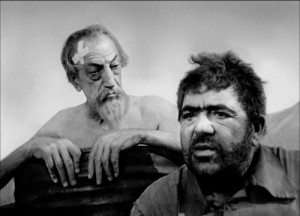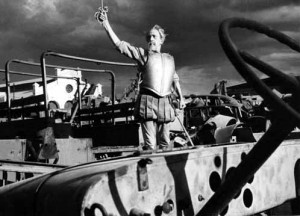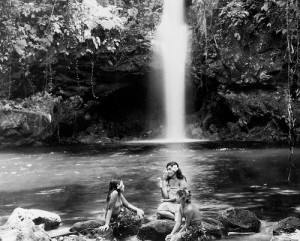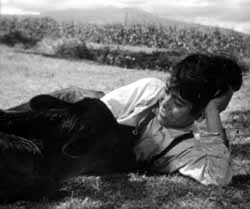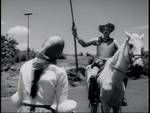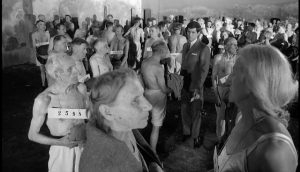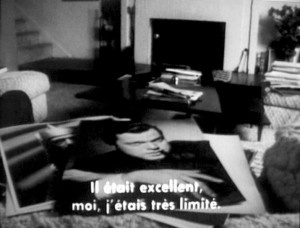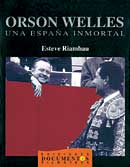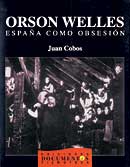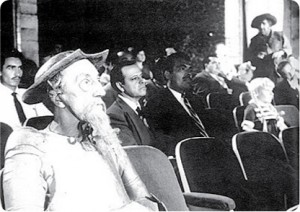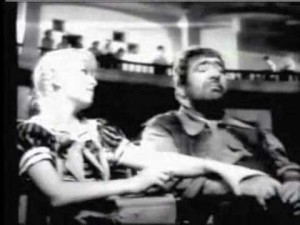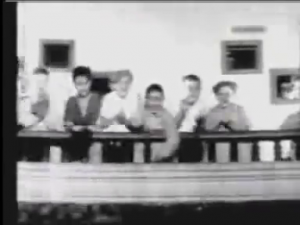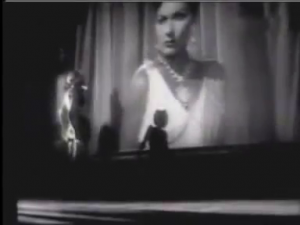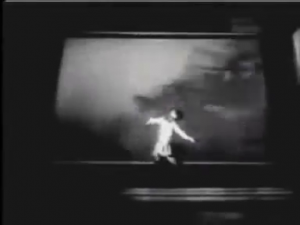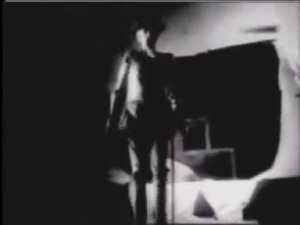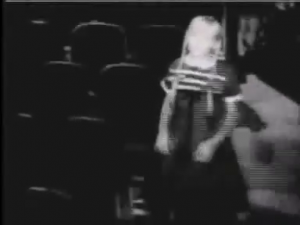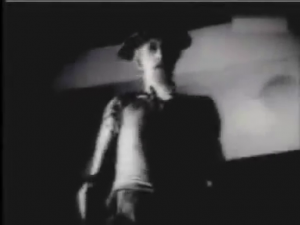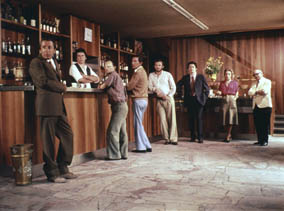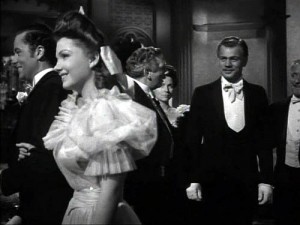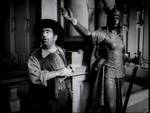Written originally for Trafic no. 12 (Fall 1994), where it appeared in French translation, translated by Bernard Eisenschitz; all three letters first appeared in English in Persistence of Vision No,. 11, 1995. — J.R.
June 13, 1994
Dear Bill,
It’s good to have all your multifaceted thoughts about It’s All True, which makes your letter worth the long wait. I especially value what you have to say regarding the political implications of the film in the 1940s as well as the 1990s, because it seems that those implications have mainly eluded critics in both decades. As you well know, it wasn’t until Robert Stam published “Orson Welles, Brazil, and the Power of Blackness” in the seventh issue of Persistence of Vision (1989), with corroborating essays by both Catherine and Susan Ryan, that it finally became clear, forty-odd years after the event, that part of what was rattling so many studio executives and Brazilian government officials alike about Welles’s behavior in Rio was his particular interest in blacks. Maybe you’re right that he wasn’t a radical, but if It’s All True had been completed and released in the early 1940s, it still might have offered a radical precedent: three Latin American stories focusing on non-white heroes.
Of course the perils of embarking on such a transcultural and translingual project were as daunting in a way for you and your American collaborators as they were for Welles and his own (with Dick Wilson the common member of both teams): given all the divergent forces at play, ambiguities and misunderstandings were almost to be expected, which helps to account for why Welles himself in later years, for purposes of telling a “good yarn,” was perfectly capable of misdescribing the death of Jacaré — not to mention inventing a nonexistent Brazilian voodoo sect in the opening footage of your documentary (a detail that I’m told has perturbed some Brazilian viewers), as well as paring away the urban trappings of Fortaleza to evoke a “natural” setting comparable to those in Moana. (Flaherty, we know, was quite capable of making similar elisions and modifications.) The process of explaining unfamiliar material and adapting it to North American norms of understanding is not simply one of translation but one of acculturation, and every stage of this project has been subject to such dangers. For all the “universality” of the Man of La Mancha and Sancho Panza, I have little doubt that Welles’s Quixote is fraught with comparable contradictions — as is, for that matter, his multinational version of Kafka.
With or without these problems, I am nonetheless struck by the evidence offered by your documentary that It’s All True might well have been the most overtly Catholic of Welles’s films — a discovery prompted in part by the revelation in Peter’s introduction to This Is Orson Welles that Welles was raised as a Catholic, a basic fact missing from the biographies of Leaming, Higham, and Brady. (Let’s hope that the Welles biographies in the works by Simon Callow and David Thomson — as well
as Bart Whaley’s book about Welles in relation to magic, which is still seeking a publisher — will know what to make of it.)(1) Consider the lovely blessing-of-the-animals scene glimpsed in your treatment of “Bonito,” the periodic visits to churches made by the jangadeiros on their raft journey from Fortaleza to Rio, or the celebrations of Carnaval itself. It’s truly discoveries of this kind that keep the Wellesian oeuvre in a perpetual state of becoming, where each new work or fragment thereof transforms our understanding of the rest.
On the other hand, even with an oeuvre as full of unexpected and still partly unexplored twists as that of Welles, we don’t want to be guilty of our own form of idealism à la Flaherty by granting his career a volition it didn’t always have. The charge of special pleading that you bring against the polemics we’ve been waging on behalf of Welles seems to me quite just in at least one important respect: that Welles
was in some ways responsible for many of the disasters that plagued his career; that, indeed, as Higham concludes and Carringer reiterates, “he was the brilliant architect of his own downfall.” Unfortunately, truths of this kind are never entirely disinterested even when they sound most reasonable, because behind them always lurk ideological as well as practical assumptions, acknowledged or otherwise: downfall, yes, but from what and to what? If we wish for a Wellesian ascension to power comparable to Spielberg’s, what would we be giving up and settling for in the process? And if Welles’s own intentionality is to serve as the ultimate criterion in gauging his own success or failure, where does that leave criticism, which thankfully left intentionality and its vagaries well behind once it decided that effects were more important than motives?
It seems to me that Welles’s continuing force as an ideological disturbance in the cinematic apparatus — a force that went well beyond his own intentions, and that continues unabated long after his death, inflecting virtually every aspect of his work — can always be explained or rationalized as a series of strategic mistakes (or bad “career moves,” as the current parlance has it). Let’s list a few of them: the refusal (or inability) of a one-time mainstream artist to accept the status — including in some cases the benefits — of a marginal art house director; a conspiratorial secrecy regarding many of his most personal projects, coupled with a compulsive need to revise them, which often led him to tell in effect several disparate acquaintances and co-workers, sometimes on separate continents, “You are the only one I can trust,” with predictably chaotic posthumous consequences; a complete inability to handle
money, coupled with an incapacity to flatter or reassure the very financiers and producers he habitually depended upon; a passion for working on several projects at once, which often meant relegating several films-in-progress to the back burner for years at a time; a failure to package himself and his projects commercially in relation to what producers wanted . . . the list could be expanded indefinitely, and, of
course, has been.
What seems objectionable to me about the listing of such flaws is not their falsity but the uses they’re generally put to — parceling out blame in order to reduce or deny the ideological disturbance, declaring Welles sick in order to assign the apparatus a clean bill of health. From the vantage point of business, such an act obviously becomes necessary, but for a historian or critic to add up these offenses merely implies a subsuming of history and criticism under business interests — a process that is already so dominant and triumphant in our culture that it scarcely
needs any assistance from a Higham or a Carringer, much less from you or me.
This has a lot to do with why the notion of attempting yet another Welles biography holds little attraction for me — much as I appreciate your flattering confidence, which I don’t happen to share. What’s needed at this stage, apart from further documentation of the work, is social history, not biography — an account of the reception of Welles as a mythological creature that continues to clog up most discourse about him, the multiple ways in which he continues to become the site of
Oedipal fantasies, the “acting out” of mythomaniacs. In this respect, André S. Labarthe’s L’homme qui a vu l’homme qui a vu l’ours, known in English as The Big O — quite apart from its genuine interest as an apotheosis of the mimetic principles of Cinéastes de notre temps, including their best and worst tendencies — is perhaps the only instance of Wellesian “research” that fully bears witness to its own perversity and partiality, so that exposing the deceptions of Henry Jaglom as Wellesian heir apparent is deemed more important than challenging the deathbed lies of John Houseman about the authorship of the Kane script, simply because Labarthe/Szabo considers himself in competition with Jaglom but not with Houseman. Clearly, the Oedipal stakes are what matter in this sort of a game more than the facts themselves. To write a biography of Welles ultimately means to invite and submit to excesses of this kind, but to write a social history, assuming anyone could do it, would be to place these excesses, to try to understand them as mechanisms within larger ideological formations.
The Orson Welles Oral History Project that you outline holds more attractions for me; although there, too, I wonder if your aspirations might be a little utopian. To attempt such an endeavor would require moving beyond the capitalist and nationalist agendas that have regulated the handling of Welles’s posthumous work so far, in one way or another, and it’s not clear to me, things being what they are, how such a project could be financed without honoring those agendas, all of which tend to be at odds with honoring the integrity of the work in its own right.
There are exceptions, of course — scattered cinephiles across the globe who are still more interested in preserving the Welles legacy for its own sake than in using it as a brand name to promote other interests. Most recently, I was delighted to learn that Criterion is planning to release a laserdisc of the original 1952 version of Othello that Welles showed in Cannes, bypassing both the 1955 version that he reedited for the U.S. and the highly debatable “restoration” of that version that was released in the U.S. to much uncritical fanfare in 1992, with postmodernist approximations of his original music and sound effects reworked in stereo, and compressions and expansions of the dialogue done in the interests of lip-sync — both signs of a blind faith in technology taking the place of research. When Criterion phoned to ask me to write liner notes for the 1952 version and mentioned that they’d be releasing The Lady from Shanghai somewhat later, I told them about the phantom “alternative” version of that film that James Naremore recalls seeing at the Frankfurt Kommunales Kino in 1981 when he ordered a print to accompany his own lecture there — a version with some scenes or shots missing but other scenes containing shots he’d never seen before, subtitled in both French and German (which suggests a Swiss or perhaps a Luxembourgian print source) — most likely a version of the film comparable to the famous “Italian version” of Foolish Wives written about by Rivette in Cahiers du cinéma no. 79, shipped out to a European location prior to its U.S. release. It’s another piece of the Shanghai puzzle to go with Jim’s superb account of the cutting continuity of the 155-minute rough cut in the second edition of his invaluable The Magic World of Orson Welles.
Indeed, if some European Welles fanatic could succeed in tracking down this alternative version of Shanghai, we’d have another instance of the transnational detective work that your dream of an Oral History Project envisages. There have been others: Ciro’s two wonderful versions of Tutta la Verità su Gregory Arkadin for RAI were labors of love that paralleled my own Arkadin research for the January–February 1992 Film Comment, which was paralleled in turn by Tim Lucas’s independent research on the separate versions of Arkadin carried out in Video Watchdog (an excellent scholarly “fanzine” in the U.S., mainly devoted to horror films) the same year. Ciro and I benefited a great deal from each other’s labors, while Lucas worked in isolation from both of us, but all three of us failed to take account of all the Spanish documentation alluded to in Esteve Riambau’s Orson Welles: Una España Inmortal, published in 1993 along with Juan Cobos’s Orson Welles: España Como Obsesión by the Filmoteca Española — impressive-looking volumes that have already sent me to my Spanish-English dictionary to glean whatever discoveries I can make from them.
Therefore, an international repository for such material would obviously be a boon to all Welles scholars. But how could such a project ever get financed without business and/or national interests eventually overtaking and engulfing all the research? Consider the unhappy fate of Quixote and all the competing agendas that assigned it that fate, including the off-screen narration intoned over the final freeze-frame of the English version of Jesus Franco’s cut: “This film was written, produced, and directed by a man whose ashes, in accordance with his last wishes, [were] scattered on Spanish soil. His name was Orson Welles.” Just as if he somehow intended the film to premiere at Expo 92 all along.
Many of these agendas, of course, can be traced directly back to Welles. Even his decision to flee from Universal studios to Mexico to start shooting the film when the editing of Touch of Evil encountered some studio resistance can be labeled a strategic move with lasting consequences, effectively ending his Hollywood career as a director in the name of independence. And much of what he wound up shooting in Mexico — specifically a series of dialogues between himself and Patty McCormack in a courtyard and later on a horse-drawn carriage, as well as a subsequent scene in a movie theater featuring McCormack, Akim Tamiroff (Panza), and Francisco Reiguera (Quixote) — he eventually decided to discard, as we know from Oja, with the intention of shooting new material with his daughter Beatrice to replace it. That is why the hasty posthumous version of the film edited by Franco for Expo 92 that
showed in Cannes the same year includes none of this material, nor does the English version (which is scheduled to show at New York’s Museum of Modern Art in the fall). I assume that when Oja made her agreement with Franco’s Spanish producer, part of the agreement regarding a commercial version of the film was that none of this material be used.
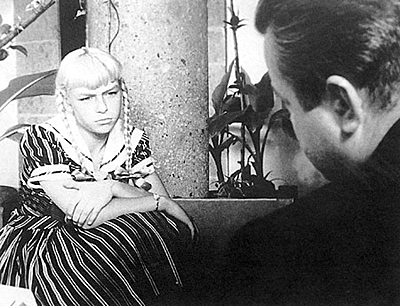
I was lucky enough to see this footage, or at least a large portion of it — still in the possession of Mauro Bonanni, who worked with Welles on the original editing — at an instructive Welles conference in Rome organized by Ciro in late October 1992, an event focusing on the same Italian collaborators of Welles who are interviewed by Ciro in his video documentary Rosabella. (Franco and his collaborators were also invited, but failed to appear, and here again nationalist agendas sometimes threatened to overtake the proceedings, hovering around the issue of whether the soul of Welles was “truly” Italian or “truly” Spanish.)
Seeing the McCormack material from end to end, without a sense of where it would be placed in the film proper — the courtyard and carriage footage with sound (mainly or exclusively direct, as I recall), the fully edited theater sequence silent — I could only marvel at the resonance it might have had as a narrative framing device; and when it came to the movie theater sequence, even without any sound, I felt privileged at being present at the one point in all the Quixote material I’ve seen when the comedy gives way not merely to pathos but to convulsive, unbearable tragedy.
Let me try to describe this sequence, as nearly as I can remember it. It’s preceded in the courtyard and carriage scenes by Welles first telling McCormack about the story of Don Quixote and eventually by McCormack describing actual personal encounters of her own with Quixote and Panza (and at one point we actually see Panza appearing mysteriously in the courtyard as well, after Welles and McCormack have left the scene). Panza is then seen entering a crowded movie theater, finding himself a seat beside McCormack, and becoming enrapt in the movie. She hands him a lollipop, then patiently shows him how to remove the wrapper after he distractedly bites into it with the paper still on, unable to tear his eyes away from the screen. (As in the remainder of Welles’s Quixote, the childlike grubbiness and innate earthiness conveyed by Tamiroff are sublime.) The two of them watch the movie together, equally absorbed. Then they notice that Quixote is also watching the film from a few rows away, and taking what he sees on the screen — a scene of various women being crucified in what appears to be a conventional 50s peplum —very seriously. He gets up from his seat, strides toward the screen with his sword, and begins slashing away at the screen to free the movie damsel in distress from her movie persecutors.
Up to this point, the scene has been gently and genuinely comic, but now it turns cruel and harsh in a manner that seems peculiar to Cervantes: the audience begins to cheer Quixote on, boys in the balcony hoot with ecstatic derision, and the doleful knight continues to slash the screen to tatters, thrusting again and again until only a few pathetic strands in the fabric remain. Pandemonium has meanwhile broken out in the auditorium, most of the audience has stormed out, and yet the knight continues heedlessly in his task, stone-faced, relentlessly — in a scene so powerfully and painfully protracted that in some way I wanted to rush toward the larger screen exposing the knight’s own futility, the screen showing Welles’s Don Quixote, and slash it to ribbons, too.
Research on Welles’s Quixote as a developing project still remains at such a primitive stage that I couldn’t begin to judge the rightness or wrongness of this material in relation to the rest, much less explain what Welles intended to replace it with. I only know that it carries a raw, primordial force in its present state that is paralleled by only a few moments in the rest of Welles’s work. Some of those few moments, to be sure, are in the Franco-edited version of Quixote. But there, I’m sorry to say, they’re often diluted and poorly served by their placement and by their poorly duped textures, both signs of unnatural haste. The English version of this cut is at least superior to the Spanish-dubbed version that premiered at Expo 92 and Cannes by virtue of having Welles’s own voice narrating and dubbing both Quixote and Panza for roughly half of the film’s running time; the remainder of the English voices seem to come from anyone the dubbing people could find to pull off the street — not that their task would have been easy under any circumstances. Worst of all is the misappropriation of footage from Welles’s Italian TV documentary series in the mid-1960s, Nella Terra di Don Chisciotte. To my mind this TV series is a piece of honest if touristic hack-work, undertaken in order to finance work on Quixote but by no stretch of the imagination a piece of Quixote itself — which, alas, is exactly how Franco has treated it. Ironically and fatally, the gap left by the deleted McCormack material has been filled by the far more debatable material of Welles cruising around Spain in the back of a limousine, playing the celebrity big shot.
Of course the pressure to complete a feature in a few weeks or months, in time for the Expo 92 deadline, out of material that had occupied Welles for many decades, made the project doomed from the outset. This implies that the real work on Quixote can only begin when scholars find their way to the Filmoteca Española in Madrid and begin to study all the many hours of Quixote material housed there, and then — unless legal matters are finally resolved and all the footage is finally brought together — pay an additional visit to Bonanni in Rome to see the remaining footage. When I suggested to Bonanni in 1992 that perhaps, given Welles’s penchant for revisions, there were not one but several Quixotes to choose from, he angrily replied that if Welles had truly decided to delete all the McCormack footage, he would have surely thrown it out (as, indeed, he did discard some of the earliest
Quixote footage he shot, back when it was still conceived of as a TV film produced by Frank Sinatra).
Given Welles’s compulsive methods of secrecy and subterfuge regarding the shooting and editing of Quixote (many of which are detailed by his former secretary Audrey Stainton in the Autumn 1988 Sight and Sound), I doubt that we’ll ever know the whole story, but in this particular area of Welles scholarship, the work hasn’t even begun. It’s not even clear to me what written sources Franco and his collaborators had at their disposal for dubbing the silent portions of the footage in Spanish and English, and until such facts and others are made available, we can’t even begin to evaluate the results — despite my provisional remarks here, based mainly on my memories of the edited sections, dubbed and silent, that Oja screened at New York University’s Welles conference in 1988. There, at least, the marvelous moment of Sancho Panza looking directly at the camera in response to Welles’s offscreen narration wasn’t underlined by an ugly zoom, which I assume was added by Franco for unnecessary punctuation. But, of course, I can’t be sure of this; with no documentation at my disposal, I can’t absolutely prove that Welles didn’t shoot another take that included that zoom, which Franco decided to retain.
We can, however, broach another issue about the etiquette of completing an unfinished film that applies equally to your version of It’s All True: namely, how does one edit material that Welles left unedited? Two antithetical approaches come to mind, both of which are found in separate portions of your film. One is to attempt to edit à la Welles, as Ed Marx has done with the blessing of the animals in “Bonito,” which in this case means to make the images fleeting, rhythmic punctuations of the offscreen narration. (Especially in his 1940s and 1950s work, Welles’s movies never linger over beauty; the pleasure of the images is almost always counteracted by a Calvinist form of abridgement and denial, rather like the extremely brief shot of the Italian partisans standing at the bar in Straub-Huillet’s From the Cloud to the Resistance. This is, in fact, true whether Welles is narrating off screen or not, and it theoretically means that, even if the Ambersons ball scene had remained uncut by RKO, it still would have left us with a sense of incompletion and regret at the end.)
The other solution, which Marx adheres to in most of the Fortaleza sequence — the part of your film without off-screen narration, although Welles would certainly have narrated it himself — is the reverse approach: to linger over the images, allow the spectator to contemplate and fully digest what is there. To what end? To permit us to savor the material, even in its necessary incompleteness. From this standpoint, which is certainly defensible, I would have to withdraw my objection to an excessive use of close-ups, for what’s at stake here isn’t a Welles sequence but Welles footage — hardly the same thing. Yet the same defense could be theoretically made for the terminal dullness of Sancho Panza wandering endlessly through urban crowds in Franco’s version of Quixote — assuming, that is, that he, like Marx, was lingering over unedited material.
The point of all these qualms is that no solution is entirely adequate when it comes to completing uncompleted projects — a problem that Peter and I faced in editing This Is Orson Welles and that your team faced in editing “Four Men on a Raft.” And one of the reasons for this necessary impasse corresponds, I’m sure, to why most of these projects were never completed within Welles’s lifetime: because the artistic and commercial answers to the various questions posed by the material are never necessarily the same answers, and to opt for one solution often means to betray the interests of the other. (Could you believe that when I interviewed him in Paris for Film Comment back in 1972, Welles told me he was reluctant to release Quixote right away because he didn’t want it to “compete” with Man of la Mancha?) Caught between the conflicting identities of a mainstream entertainer (as he was in his TV appearances and in his turns as a “colorful” actor in the films of others) and of a private artist, with one foot firmly planted in each camp, Welles spent most of his life negotiating a contradiction that his chroniclers and archivists also have to face. And given the state of cinema in 1994, why should our task be any easier than his?
As ever,
Jonathan (2)
***
End Notes
1. (March 1995): In Whaley’s case, we don’t have to wait for his finished book. (Callow’s is scheduled for publication in England this month.) In a letter to me dated 7 November 1994 that includes his responses to the above, he expresses a good deal of skepticism about Welles’s statement to Bogdanovich, noting that “Riambau (p. 17) writes that the Archbishop of Madrid approved the burial of Orson’s ashes on Spanish soil in 1987 despite having satisfied himself that they weren’t Catholic ashes.” And in the same letter, Whaley reports that both Robert Wise and Betty Wilson “categorically denied” Endfield’s allegation “that Jack Moss was disloyal to Welles in 1942.” (“Both accepted Endfield’s facts but reject his sinister conclusion.”) He also questions whether Wise was responsible for the “overlit” restoration of Kane, noting that his role was only that of a consultant. (J.R.)
2. As a point of reference, the principal surviving Welles films that have not yet been released due to practical, legal, and/or financial difficulties are The Deep (a thriller shot off the Dalmatian coast between 1967 and 1969), The Merchant of Venice (a 40-minute condensation of the Shakespeare play, completed circa 1970 but never shown after most of its soundtrack was stolen), and The Other Side of the Wind (shot in Europe and the U.S. between 1970 and 1976). The rights to all three were willed by Welles to Oja Kodar.
— This exchange was originally commissioned by and written for Trafic; the first letter was published in issue no. 12 (Fall 1994), the latter two in issue no. 13 (Winter 1995), translated into French by Bernard Eisenschitz
The principal texts cited or alluded to in the above letters are as follows:
Bordwell, David, and Kristin Thompson. Film Art: An Introduction, 4th edition.
New York: McGraw-Hill, 1993.
Carringer, Robert L. The Magnificent Ambersons: A Reconstruction. Berkeley: University of California Press, 1993.
———. The Making of Citizen Kane. Berkeley: University of California Press, 1985.
Combs, Richard. “Burning Masterworks: From Citizen Kane to F for Fake.” Film
Comment, January–February 1994.
Higham, Charles. Orson Welles: The Rise and Fall of an American Genius. New York: St. Martin’s Press, 1985.
———. The Films of Orson Welles. Berkeley: University of California Press, 1970.
Kael, Pauline. “Raising Kane.” In The Citizen Kane Book. Boston: Little, Brown,
1971.
Krohn, Bill. “The Class: Rencontre avec Nicholas Ray.” Cahiers du cinéma no. 288, May 1978.
———. “Entretien avec Orson Welles.” Cahiers du cinéma nos. 383–384, May 1986.
———. “La force de l’oeuvre.” Orson Welles. Paris: Editions de L’Etoile, 1986.
(Note: this book also contains the previous and two following Krohn texts.)
———. “Les inachèves d’Orson Welles: L’héritage.” Cahiers du cinéma no. 378, December 1985.
———. “It’s All True: A la récherche du film fantôme.” Cahiers du cinéma no. 375, September 1985.
———. “Lettre d’un ami américain.” Trafic no. 1, winter 1991.
Lucas, Tim. “The Cutting Room Floor.” Video Watchdog no. 10, March–April 1992.
———. “Mr. Arkadin: The Research Continues.” Video Watchdog no. 12, July–August 1992.
Mulvey, Laura. Citizen Kane. London: British Film Institute, 1992.
Naremore, James. The Magic World of Orson Welles, 2nd edition. Dallas: Southern Methodist University Press, 1989.
Riambau, Esteve. Orson Welles: Una España Inmortal. Published with Juan Cobos’s Orson Welles: España Como Obsesión. Madrid: Filmoteca Española, 1993.
Rosenbaum, Jonathan. “The Invisible Orson Welles: A First Inventory.” Sight and
Sound, Summer 1986.
———. “Othello Goes Hollywood.” Chicago Reader, April 10, 1992. Reprinted in
Placing Movies: The Practice of Film Criticism. Berkeley: University of California Press, 1995.
———. “The Seven Arkadins.” Film Comment, January–February 1992. Reprinted in Movies as Politics. Berkeley: University of California Press, 1997.
———. “The Voice and the Eye: Commentary on the Heart of Darkness Script”
and “Paris Journal.” Film Comment, November–December 1972.
Stainton, Audrey. “Don Quixote: Orson Welles’ Secret.” Sight and Sound, Autumn 1988.
Stam, Robert. “Orson Welles, Brazil, and the Power of Blackness.” Published with
related texts by Susan Ryan and Catherine Benamou. Persistence of Vision, no.
7, 1989.
Welles, Orson. The Cradle Will Rock: An Original Screenplay. Introduction by James Pepper; afterword by Jonathan Rosenbaum. Santa Barbara: Santa Teresa
Press, 1994.
———. “Memo to Universal” (on Touch of Evil). Introduced by Jonathan Rosenbaum. Film Quarterly 46, no. 1, Fall 1992. (Also appeared in French in Trafic no. 4, Fall 1992.)
Welles, Orson, and Peter Bogdanovich. This Is Orson Welles, edited by Jonathan
Rosenbaum. New York: HarperCollins, 1992. Audio edition: New York:
Caedmon, 1992. English edition: London: HarperCollins, 1993. French edition
(Moi, Orson Welles): Paris: Belfont, 1993. (See review by Bill Krohn in Cahiers du cinéma no. 470, July–August 1993, for errors in the French translation.) Italian
edition (Io, Orson Welles): Milan: Baldini & Castoldi, 1993. German edition (Hier spricht Orson Welles): Berlin: Quadriga Verlag, 1994.
Welles, Orson, with Oja Kodar. The Big Brass Ring: An Original Screenplay (preface by James Pepper, afterword by Jonathan Rosenbaum), Santa Barbara:
Santa Teresa Press, 1987. Italian edition (La posta in gioco): Genova: Costa &
Nolan, 1989. English edition: London: Black Spring Press, 1991.
— Persistence of Vision no. 11, 1995

